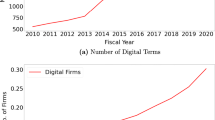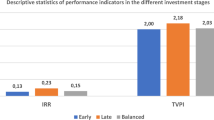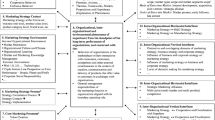Abstract
This paper examines whether investors recognize the value of managerial flexibilities, as proxied by real options, in their valuation of new product introductions. We define a firm’s real options portfolio as the difference between the firm’s market value and its assets in place. A firm’s strategic flexibilities are modeled as the ratio of its real option portfolio to its book value. Using a sample of new product introductions from 1998–2007, we find our real options measure is positively related to announcement period abnormal returns. This result holds after we control for other variables known to be correlated with the announcement effect in previous studies. Our result is robust to alternative measures of real options based on analysts’ earnings expectations and whether a firm has one or multiple segments. In summary, our results suggest that a firm’s perceived strategic and operating flexibilities are an important factor in the valuation of new products.
Similar content being viewed by others
Notes
In sensitivity analysis, we relax this assumption and obtain a more accurate real option measure for new products by restricting our sample to single-segment firms. Our inferences remain unchanged.
Assuming the book value of assets approximately equals the book value of the firm’s assets in place, the real-option portfolio as a percentage of the firm’s market value is 2.740/(1 + 2.740) = 73 %.
This result is largely consistent with Pindyck (1988), who suggests that a firm’s capital in place accounts for less than 50 % of its value, and this weight may further decrease with higher volatility in demand for the firm’s product. Using the volatility of a firm’s quarterly sales (weighted by average quarterly sales) over a three-year period prior to the announcement as a proxy for product demand volatility, we find our real option measure is significantly positively associated with demand volatility.
We examined the variance inflation factors (VIFs) for each of our multivariate regressions and none of the calculated VIFs exceed two, suggesting that multicollinearity is unlikely to be a problem.
The adjusted R2 of the full model is 0.076. The low R2 seems to be a norm in event studies on new product introductions. The explanatory power of our model is comparable to those reported in prior studies. For example, the adjusted R2 in a study by Chaney et al. (1991) is only 0.033, while the model used in Chen et al. (1991) has more explanatory power with an adjusted R2 of 0.087.
For example, IBM simultaneously ran seven business divisions in 2006, namely: (1) software, (2) global financing, (3) system/technology group, (4) global technology service, (5) global business service, (6) others and adjustments, and (7) eliminations. It is obvious that products or services from some divisions (e.g. software) may be significantly different from those from other divisions (e.g. global financing).
Our inferences remain unchanged if we use the alternative measure based on the analysts’ forecasts. The sample size is dramatically reduced as a result of requiring available data from both I/B/E/S and Compustat segment files.
Specifically, an individual firm’s state vector includes three firm specific state variables: mean-adjusted log excess return over the announcement quarter, mean-adjusted log book to market ratio, and mean-adjusted log profitability (proxied by return on equity). We estimate the VAR by industry using one pooled prediction regression per state variable.
References
Aguerrevere FL (2009) Real options, product market competition, and asset returns. J Finance 64:957–983
Baldwin CY, Ruback RS (1986) Inflation, uncertainty, and investment. J Finance 41:657–669
Berger PG, Ofek E, Swary I (1996) Investor valuation of the abandonment option. J Financ Econ 42:257–287
Berk JB, Green RC, Naik V (1999) Optimal investment, growth options, and security returns. J Finance 54:1553–1607
Bollen NP (1999) Real options and product life cycles. Manage Sci 45:670–684
Brealey RA, Myers SC, Franklin A (2008) Principles of corporate finance. McGraw-Hill/Irwin, New York
Brennan MJ, Schwartz ES (1985) Evaluating natural resource investments. J Bus 58:135–157
Bulow J, Geanakoplos JD, Klemperer P (1985) Multimarket oligopoly, strategic substitutes and complements. J Polit Econ 93:488–511
Buzzell RD, Gale BT (1987) The PIMS principles: linking strategy to performance. Free Press, New York
Campbell JY (1991) A variance decomposition for stock returns. Econ J 101:157–179
Carlson M, Fisher A, Giammarino R (2006) Corporate investment and asset price dynamics: implications for SEO event studies and long-run performance. J Finance 61:1009–1034
Chan SH, John DM, Kensinger JW (1990) Corporate research and development expenditures and share value. J Financ Econ 26:255–276
Chaney PK, Devinney MT, Winer RS (1991) The impact of new product introductions on the market value of firms. J Bus 64:573–610
Chauvin KW, Hirschey M (1993) Advertising, R&D expenditures and the market value of the firm. Financ Manage pp 128–140
Chen SS, Ho KW (1997) Market response to product-strategy and capital-expenditure announcements in Singapore: investment opportunities and free cashflow. Financ Manage 26:82–88
Chen SS, Ho KW, Ik KH, Lee CF (2002) How does strategic competition affect firm values? A study of new product announcements. Financ Manage 31:67–84
Chen SS, Ho KW, Ik KH (2005) The wealth effect of new product introductions on industry rivals. J Bus 78:969–996
Chen SS, Chung TY, Ho KW, Lee CF (2007) Intra-industry effects of delayed new product introductions. Rev Pac Basin Financ Mark Policies 10:415–443
Chung KH, Charoenwong C (1991) Investment options, assets in place, and the risk of stocks. Financ Manage 20:21–33
Conner KR, Prahalad CK (1996) A resource-based theory of the firm, knowledge versus opportunism. Organ Sci 7:477–501
Copeland TE, Antikarov V (2001) Real options: a practitioner’s guide. Texere, New York
Cummins JG, Hassett KA, Oliner SD (2006) Investment behavior, observable expectations, and internal funds. Am Econ Rev 96:795–810
Da Z, Guo R, Jagannathan R (2012) CAPM for estimating the cost of equity capital: interpreting the empirical evidence. J Financ Econ 103:204–220
Danbolt J, Hirst I, Jones E (2002) Measuring growth opportunities. Appl Financ Econ 12:203–212
Das S, Guo R, Zhang H (2006) Analysts’ selective coverage and subsequent performance of newly public firms. J Finance 61:1159–1185
Eisenhardt KM, Martin JA (2000) Dynamic capabilities: what are they? Strateg Manage J 21:1105–1121
Fama E, MacBeth F, James D (1973) Risk, return, and eqilibrium: empirical tests. J Polit Econ 81:607–636
Hendricks KB, Singhal V (1997) Delays in new product introductions and the market value of firm: the consequence of being late to the market. Manage Sci 43:422–436
Jensen MC (1986) Agency costs of free cashflow, corporate finance, and takeovers. Am Econ Rev 76:323–329
Kelm KM, Narayanan VK, Pinches GE (1995) Shareholder value creation during R&D innovation and commercialization stages. Acad Manage J 38:770–786
Kester WC (1984) Today’s options for tomorrow’s growth. Harvard Bus Rev 62:153–165
Kester WC (1986) An option approach to corporate finance. In: Altman E (ed) Handbook of corporate finance, 2nd edn. Wiley, New York
Kester WC (1993) Turning growth options into real assets. In: Aggarwal R (ed) Capital budgeting under uncertainty, 1st edn. Prentice Hall, New Jersey
Kulatilaka N (1988) Valuing the flexibility of flexible manufacturing systems. IEEE T Eng Manage 35:250–257
Kulatilaka N, Trigeorgis L (2004) The general flexibility to switch: real options revisited. In: Schwartz ES, Trigeorgis L (eds) Real options and investment under uncertainty: classical readings and recent contributions, 1st edn. MIT Press, Massachusetts, pp 179–198
Lang LH, Stulz RM, Walkling RA (1989) Managerial performance, Tobin’s Q, and the gains from successful takeovers. J Financ Econ 24:137–154
Lang LH, Stulz RM, Walkling RA (1991) A test of the free cash flow hypothesis: the case of bidder returns. J Financ Econ 29:315–335
Lin WT (2002) Computing a multivariate normal integral for valuing compound real options. Rev Quant Financ Acc 18:185–209
Lin WC, Chang SC (2011) Corporate governance and the stock market reaction to new product announcements. Rev Quant Finan Acc doi: 10.1007/s111560110248x
Mason SP, Merton RC (1985) The role of contingent claims analysis in corporate finance. In: Altman E, Subrahmanyam M (eds) Recent advances in corporate finance, 1st edn. Richard D. Irwin, Illinois, pp 7–54
McDonald R, Siegel D (1985) The value of waiting to invest. Q J Econ 101:707–727
Miles JA (1986) Growth options and the real determinants of systematic risk. J Bus Finan Account 13:95–105
Mintzberg H (1987a) The strategy concept I: the five P’s of strategy. Calif Manage Rev 30:11–24
Mintzberg H (1987b) The strategy concept II: another look at why organizations need strategies. Calif Manage Rev 30:25–32
Mintzberg H (1994) The rise and fall of strategic planning. Prentice-Hall, New Jersey
Neely JE (1998) Improving the valuation of research and development: a composite of real options, decision analysis and benefit valuation frameworks. Dissertation, MIT
Neely JE, Neufville RD (2001) Hybrid real options valuation of risky product development projects. Int J Technol Policy Manage 1:29–46
Pennings E, Lint O (2000) Market entry, phased rollout or abandonment? A real option approach. Eur J Oper Res 124:125–138
Pindyck R (1988) Irreversible investment, capacity choice, and the value of the firm. Am Econ Rev 78:969–985
Porter ME (1980) Competitive strategy. Free Press, New York
Schneider M, Tejeda M, Dondiw G, Herzog F, Keel S, Geering H (2008) Making real options work for practitioners: a generic model for valuing R&D projects. R&D Manage 38:85–106
Schwartz ES (2004) Patents and R&D as real options. Econ Note 33:33–54
Stulz RM (1982) Options on the minimum of two risky assets. J Financ Econ 10:161–185
Szewczyk SH, Tsetsekos GP, Zantout Z (1996) The valuation of corporate R&D expenditures: evidence from investment opportunities and free cash flow. Financ Manage 25:105–110
Teece DJ, Pisano G, Shuen A (1997) Dynamic capabilities and strategic management. Strateg Manage J 18:509–533
Trigeorgis L (1988) A conceptual options framework for capital budgeting. Adv Future Option Res 3:145–167
Trigeorgis L, Mason SP (1987) Valuing managerial flexibility. Midland Corp Financ J 5:14–21
Vuolteenaho T (2002) What drives firm-level stock returns? J Finance 57:23–264
White H (1980) A heteroskedasticity-consistent covariance matrix estimator and a direct test for heteroskedasticity. Econometrica 48:817–838
Author information
Authors and Affiliations
Corresponding author
Rights and permissions
About this article
Cite this article
Hu, C., Jiang, W. & Lee, Cf. Managerial flexibility and the wealth effect of new product introductions. Rev Quant Finan Acc 41, 273–294 (2013). https://doi.org/10.1007/s11156-012-0310-3
Published:
Issue Date:
DOI: https://doi.org/10.1007/s11156-012-0310-3




